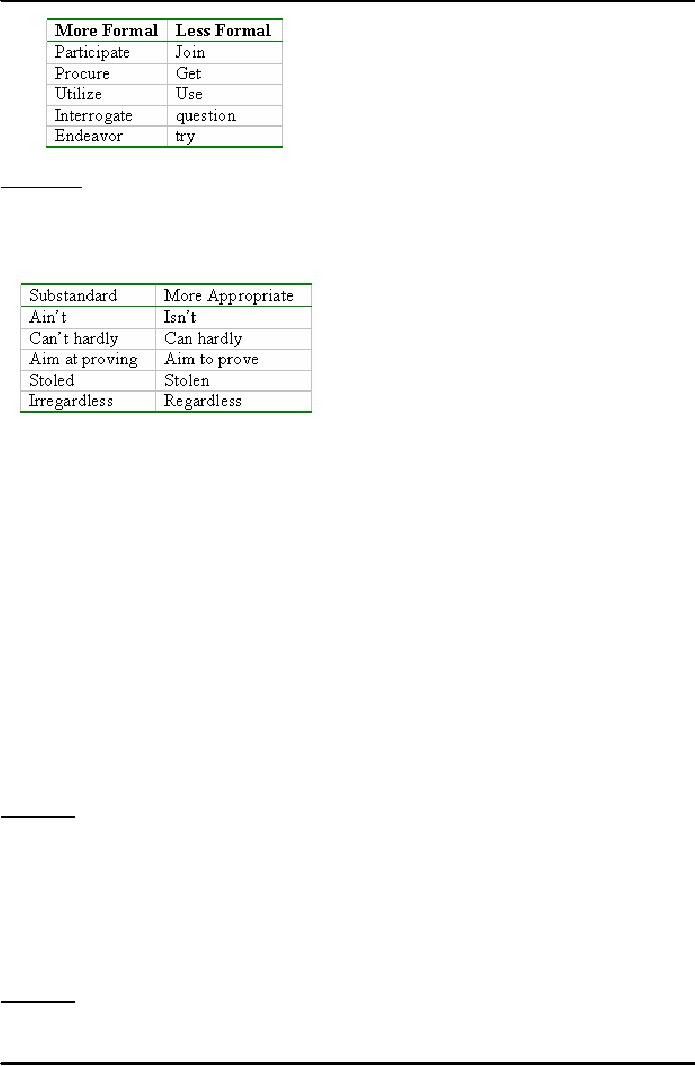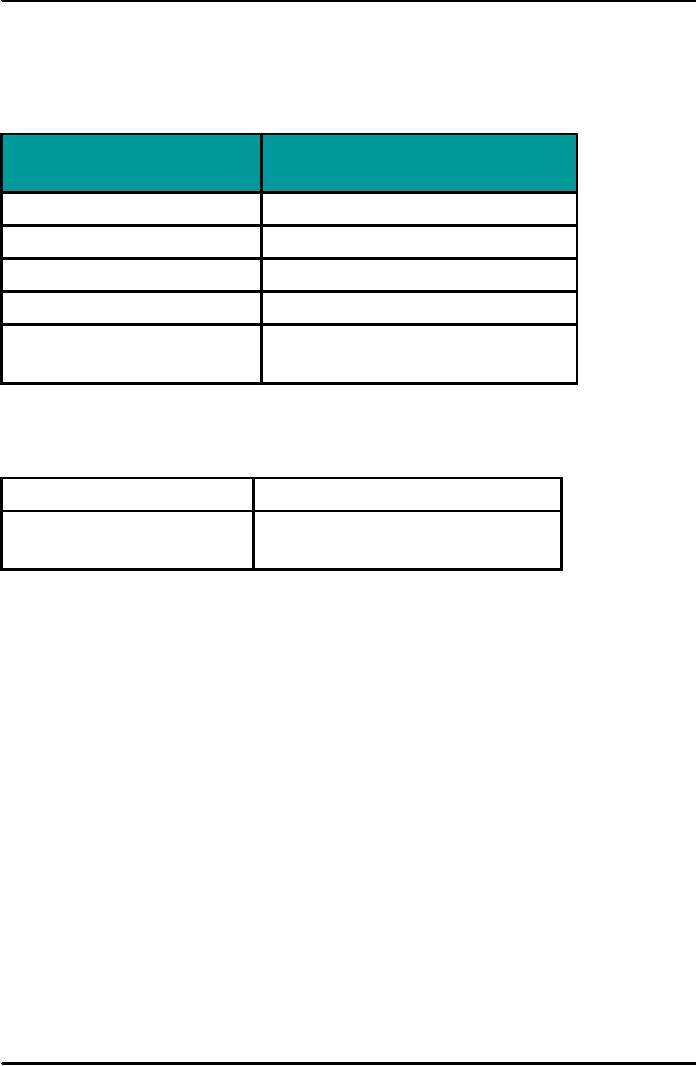 |
CORRECTNESS:Conciseness, Conciseness Checklist, Correct words |
| << PRINCIPLES OF BUSINESS COMMUNICATION:Clarity |
| CONSIDERATION:Completeness >> |

VU
Lesson
10
CORRECTNESS
�
The
correctness principle is more
than proper grammar,
punctuation and
spelling.
�
A
message may be perfect grammatically
mechanically but still lose
a customer and fail to
achieve a
purpose.
Though mistakes are never
intentional, they spoil our
image. Errors in the messages
fall in
the
following categories:
Mistakes
in names, figures, facts,
and words.
Mistakes
in punctuation and capitalization
Mistakes
in the level of Language
Mistakes
in names, figures, facts,
and words
�
Any
mistakes in names, figures,
facts, etc, can make
your message unclear. Such
mistakes can also
create
problems for you. Imagine if
you write 2000 where
you were supposed to write
200.
�
Mistakes
in punctuation and capitalization must be
avoided.
�
So be
careful to:
�
Verify
your statistical
data.
�
Double-check
your totals.
�
Avoid
guessing at laws that have
an Impact on you and your
receiver.
Mistakes
in the level of Language
�
There
are two types of writings:
formal and informal. In
formal writing, our style
is
unconversational.
In informal writing, we use
words that are short,
familiar and
conversational.
�
A
formal style is characterized by
more complex sentences.
�
An
informal style is characterized by Short
words and sentences
(Thanks
a lot for your
letter).
�
Contraction
& Abbreviations (I haven't, there's)
simple words.
Correctness:
At
the core of correctness is
proper
�
Grammar
�
Punctuation
�
Spelling
The
term correctness applied to
business messages also means
the following
characteristics.
�Use
the right level of
language
�Check
accuracy of figures, facts and
words
�Maintain
acceptable writing
mechanics
The
term correctness applied to
business messages also means
the following
characteristics.
�Use
the right level of
language
�Check
accuracy of figures, facts and
words
�Maintain
acceptable writing
mechanics
Formal
Writing
Formal
writing is often associated
with scholarly
writing.
Examples
doctoral
dissertations, scholarly articles,
top-level government agreements
etc
The
style unconventional, usually impersonal,
and contains long and
involved sentences.
Informal
Writing
This
style of writing is more characteristic
in business writing.
An
example is the communications via
E-mail, memos etc.
23

VU
Reminder:
�
Avoid substandard
language.
�
Using incorrect words, incorrect grammars,
faulty pronunciation all
suggest inability to use
good English.
Check
accuracy of figures, facts and
words
�
It is impossible to convey the
meaning of the words
precisely, through words,
from the head of
the
sender to the receiver.
�
Our goal is to be as precise as
possible.
A
good check of data is to
have another person read and
comment on the validity of
the material.
Figures
and Facts
�
Verify your statistical
data.
�
Double check your
totals.
�
Avoid guessing at Laws that
have an impact on you.
Continued....
�
Have someone else read
your message if the topic
involves data.
�
Determine whether a fact has
changed overtime.
Words
that confuse
English
language is constantly changing.
Though
dictionaries cannot keep up
with rapid change, but still
are the most useful
resource for
finding
correct words.
Example:
a,
an
Use
a
before
consonant and consonant
sounds or a long a
sound.
Use an
before
vowels
or silent h
sounds.
Example
accept,
except
Accept
is a verb that means
receive.
Except
is a verb that relates to
omitting out or leaving
out.
Example:
Between,
Among
Between
involves two people, among,
three or more.
24

VU
Example:
Farther,
further
Farther
is used to express more
distance in space, further
for distance in time,
quality or
degree.
Example:
Biannually,
biennially
Biannually
mean two time a year,
biennially means every two
years.
Maintain
Acceptable Writing
Mechanics
All
material relating to mechanics, word
processing and appearance is
relevant here.
A
careful attention to the
mechanical part of every well-written
document.
Conciseness
Eliminate
wordy expressions
�
To
avoid wordy expressions, use
single words whenever
possible. Here are some
examples of how
word
economy saves the reader's time
and effort.
�
Wordy:
I want to
take this opportunity to tell
you that we are grateful to
you
�
Concise:
Thank
you
�
Wordy:
We are
grateful and appreciative
�
Concise:
We
look forward with
anticipation to...
�
Avoid
trite, "which" that clauses
whenever possible
�
We
wan to buy chairs which
are of the executive
types
�
We want to
buy executive type
chairs
Include
only relevant material
�
Your
reader will lose interest in
your message if he/she finds
irrelevant things in your message.
Using
only well-chosen words can
help you convey relevant
facts.
�
Avoid,
information obvious to the
reader
�
Avoid
long introduction, excessive
adjectives, pompous works
Conciseness
Avoid
unnecessary repetition.
�
Avoid
repetition by using pronouns, short names
or acronyms, etc.
�
Stick
to the purpose of the message.
�
Writing
concisely means using only
necessary, meaningful words.
Conciseness
is saying what you want to
say in the fewest possible
words without sacrificing
the
other
C qualities.
�
A concise message saves time
and expense for both
the sender and the
receiver.
��
It increases emphasis in the
message.
��
It shows respect for the
recipient, by not cluttering them
unnecessary information.
To
achieve conciseness, observe
the following
suggestions.
�
Eliminate wordy
expressions
�
Include only relevant
material
�
Avoid unnecessary
repetition
Eliminate
wordy expressions
Use
single-word substitutes instead of
phrases whenever possible
without changing meaning.
Wordy
: At this time
Concise
: Now
Wordy
: Due to the fact
that
Concise
: because
Use
single-word substitutes instead of
phrases whenever possible
without changing meaning.
25

VU
Wordy
: have need for
Concise
: Need
Wordy
: In due course
Concise
: Soon
Omit
trite, unnecessary
expressions
Wordy
: Please be advised that
your admission statement has
been received.
Concise
: Your admission statement has
been received.
Replace
wordy conventional statements
with concise ones.
Wordy
: Please find attached the
list you requested.
Concise
: The list you requested is
attached.
Replace
wordy conventional statements
with concise ones.
Wordy
: Such refreshing comments
are few and far
between.
Concise
: Such refreshing comments are
scarce.
Avoid
overusing empty
phrases.
Wordy
: There are four rules that
should be observed.
Concise
: Four rules must be
observed.
Avoid
overusing empty
phrases.
Wordy
: It was known by Mr.. Usman
that we must reduce size
our inventory.
Concise
: Mr.. Usman knew we must
reduce our inventory.
Omit
"which" and "that" clause
where ever possible.
Wordy
: She bought desks that
are of the executive type.
Concise
: She bought executive type
desks.
Omit
"which" and "that" clause
where ever possible.
Wordy
: The receipt that is
enclosed documents your
purchase.
Concise
: The enclosed receipt
documents your
purchase.
Eliminate
unnecessary prepositional phrase.
Wordy
: The issue of most
relevance is teamwork.
Concise
: The most relevant issue is
teamwork.
Eliminate
unnecessary prepositional phrase.
Wordy
: In most cases the date of
the inquiry is indicated in
the upper right
corner.
Concise
: The policy date is in the
upper right corner.
Limit
your passive voice.
Wordy
: The total balance due
will be found on Page 2 of
this report.
Concise
: The balance due is on page
2 of this report.
Limit
your passive voice.
Wordy
: The reports are to be
submitted by employees prior to
5:00 p.m.; at which
time
they
will
be received by Ali.
Concise
: Please submit your reports
to Ali by 5:00 p.m.
Include
only relevant material
1.
Stick
to the purpose of the
message.
2.
Delete
irrelevant words and
rambling sentences.
3.
Omit
information obvious to the
reader.
4.
Avoid
long introductions, unnecessary
explanations, pompous words and
gushy
politeness.
5.
Get
to the important point
tactfully and concisely.
Example:
Wordy
: We hereby wish to let you
know that our company is
pleased with
the
confidence
you
have reposed in us.
Concise
: We appreciate your confidence.
26

VU
Avoid
unnecessary Repetition
Unnecessary
repetition leads to dullness.
Use
short names when you
have mentioned the long one
once. For Shaukat Khanum
Memorial
Cancer
Hospital, use Shaukat Khanum
or simply the
Hospital.
2.
Use
initials instead of repeating
long names. Instead of using
Pakistan
International
Airlines, use PIA.
3.
Cut
out needless repetition of
phrases or sentences.
Sometimes
it is possible to combine two or even
three sentences using
subordinate
clauses or phrases.
Example:
�The
following letter is from a
business executive in a Company for 5
years
Will
you ship us some time,
anytime during the month of
October would be fine, or
even
November
if you are rushed (November
would suit us just as well,
in fact a little bit better)
300 of
the
regular Dell Computers.
Thank
you in advance for sending
these along in parcel post, and
not in express, as
express
is
too expensive.
Concise
Version of the
Letter:
Please
ship parcel post, before the end of
November 300 Dell
Computers.
Conciseness
Checklist:
�Use
one word in in place of phrases; one
sentence in place of two.
Read out loud to listen
for
wordiness.
�Omit
outdated trite expressions.
�Ask
yourself: what material is really
relevant?
�Look
for unnecessary repetition:
Does the same word or
idea appear too often
?
Recognizing
incorrect words
1.
Simple
words. Rewrite
the following sentences,
substituting simple words
for the underlined
words
and phrases in the
sentences
A
conference call will afford us an
opportunity to interrogate the numerous
remuneration
proposals
and consummate the
rumors.
2.
Concise
words. Delete
the extra words and rewrite
these sentences.
I
want to take this
opportunity to thank you for
arranging to send me a computer
that is
exactly
identical to the one in my office. This
letter is to acknowledge receipt of
and thank you
for
your check no 389939 in the
amount of Rs. 1000.
3.
We
have 30 reservations at the
present writing, so I am taking the
liberty of sending you
an
updated
list.
4.
Correct
words. Substitute
correct words for the
underlined words that are
incorrect.
Between
you and I she has a
long ways to go to be a realator. Irregardless of
the person which
you
select, I am real pleased
with the candidates. I don't
have but two pair of
shoes.
27

VU
Hi
/ Dear Mr Imran
Thanks
/ thank you for your recent
letter. We were happy / pleased to
hear that you are interest
in
marketing
our range of children
garments
But/however,
before we make any firm decision
make up our mind, we would
be grateful if you
would
provide us with / give us
further information concerning /
about the organization of
your
firm,
the territory it covers, the
number of retail outlets and
your market share.
You
would have to get us / we
would expect a minimum
turnover of 600,000 before being in
a
position
to / we could offer you a
agency. We would want to get
/ we would wish to achieve
a
market
share of at least 10% in the
first two years.
Anyway/
this said, if you feel your
firm is able to meet these
targets it would be nice / it
would be
useful
to arrange an appointment to have a chat
about / discuss the project
in a bit more detail
further.
I
will be in English from 5 12
May and suggest we meet /
get together then, if this
is convenient
/OK.
Please
confirm with my secretary if
this is all right /
satisfactory.
I
look forward to hearing from
you in the near future /
hope to get a letter from
you soon.
Yours
sincerely, /All the best
Asif
Courtesy
�
Courtesy
does not mean the use of
old-fashioned expressions such as `your
kind enquiry', `thank
you'
and `please'. Rather, it is
politeness that grows out of
respect and concern for
others. Courtesy
is
a quality that enables a
request to be refused without
killing all hope of future
business. Courtesy
also
means replying promptly to
all letters. If you feel
your correspondent's comments
are unfair,
try
to answer tactfully. In short, the whole
letter should have a courteous tone. It
is not what you
say,
it is how you say
it.
�
The
following are suggestions
for producing a courteous
tone:
Be
sincerely tactful, thoughtful,
and appreciative
Use
expressions that show
respect
Choose
nondiscriminatory expressions
Courtesy
Be
sincerely tactful, thoughtful,
and appreciative
�
Sometimes
you have to deal with
unpleasant messages. Always
remember that by using tact
and
being
thoughtful you can convey
anything, however unpleasant it may be,
to your readers.
�
We
have believe that the extent of
your current obligations makes you a
bad credit risk.
�
Our
credit department believes that, because of
your current obligations additional credit
might be
difficult
for you to handle at this
time.
Use
expressions that show
respect
�
Expressions
like, `irresponsible' or `I do not
agree with' etc., are
annoying. Use expressions
that
show
respect for your reader
and help him think
positively about your
message.
28

VU
Courtesy
Choose
nondiscriminatory expressions
�
Courtesy
also requires use of
nondiscriminatory expressions that refer
to any particular, gender,
race,
ethnic. origin, etc.
Instead
of these gender-specific words.
Choose these Bias Free
words
Businessman
Business
person or business
worker
Chairman
Chair,
chairperson, worker,
employee
Manpower
Worker,
employee
Newsman
Newscaster
or reporter or journalist
Salesman
Salesperson,
sales, representative,
agent
Courtesy
Singular
Pronoun
He
Him
Each
customer will be notified
his bill Customers will be
notified on their
bills
(rewarded
into the plural)
29
Table of Contents:
- COMMUNICATION:Definition of Communication, Communication & Global Market
- FLOW OF COMMUNICATION:Internal Communication, External Communication
- THEORIES OF COMMUNICATION:Electronic Theory, Rhetorical Theory
- THE PROCESS OF COMMUNICATION & MISCOMMUNICATION:Message
- BARRIERS IN EFFECTIVE COMMUNICATION /COMMUNICATION FALLOFF
- NON- VERBAL COMMUNICATION:Analysing Nonverbal Communication
- NON- VERBAL COMMUNICATION:Environmental Factors
- TRAITS OF GOOD COMMUNICATORS:Careful Creation of the Message
- PRINCIPLES OF BUSINESS COMMUNICATION:Clarity
- CORRECTNESS:Conciseness, Conciseness Checklist, Correct words
- CONSIDERATION:Completeness
- INTERCULTURAL COMMUNICATION
- INTERCULTURAL COMMUNICATION:Education, Law and Regulations, Economics
- INDIVIDUAL CULTURAL VARIABLES:Acceptable Dress, Manners
- PROCESS OF PREPARING EFFECTIVE BUSINESS MESSAGES
- Composing the Messages:THE APPEARANCE AND DESIGN OF BUSINESS MESSAGES
- THE APPEARANCE AND DESIGN OF BUSINESS MESSAGES:Punctuation Styles
- COMMUNICATING THROUGH TECHNOLOGY:Email Etiquette, Electronic Media
- BASIC ORGANIZATIONAL PLANS:Writing Goodwill Letters
- LETTER WRITING:Direct Requests, Inquiries and General Requests
- LETTER WRITING:Replies to Inquiries, Model Letters
- LETTER WRITING:Placing Orders, Give the Information in a Clear Format
- LETTER WRITING:Claim and Adjustment Requests, Warm, Courteous Close
- LETTER WRITING:When The Buyer Is At Fault, Writing Credit Letters
- LETTER WRITING:Collection Letters, Collection Letter Series
- LETTER WRITING:Sales Letters, Know your Buyer, Prepare a List of Buyers
- MEMORANDUM & CIRCULAR:Purpose of Memo, Tone of Memorandums
- MINUTES OF THE MEETING:Committee Members’ Roles, Producing the Minutes
- BUSINESS REPORTS:A Model Report, Definition, Purpose of report
- BUSINESS REPORTS:Main Features of the Report, INTRODUCTION
- BUSINESS REPORTS:Prefatory Parts, Place of Title Page Items
- MARKET REPORTS:Classification of Markets, Wholesale Market
- JOB SEARCH AND EMPLOYMENT:Planning Your Career
- RESUME WRITING:The Chronological Resume, The Combination Resume
- RESUME & APPLICATION LETTER:Personal Details, Two Types of Job Letters
- JOB INQUIRY LETTER AND INTERVIEW:Understanding the Interview Process
- PROCESS OF PREPARING THE INTERVIEW:Planning for a Successful Interview
- ORAL PRESENTATION:Planning Oral Presentation, To Motivate
- ORAL PRESENTATION:Overcoming anxiety, Body Language
- LANGUAGE PRACTICE AND NEGOTIATION SKILLS:Psychological barriers
- NEGOTIATION AND LISTENING:Gather information that helps you
- THESIS WRITING AND PRESENTATION:Write down your ideas
- THESIS WRITING AND PRESENTATION:Sections of a Thesis (Format)
- RESEARCH METHODOLOGY:Studies Primarily Qualitative in Nature
- RESEARCH METHODOLOGY:Basic Rules, Basic Form, Basic Format for Books